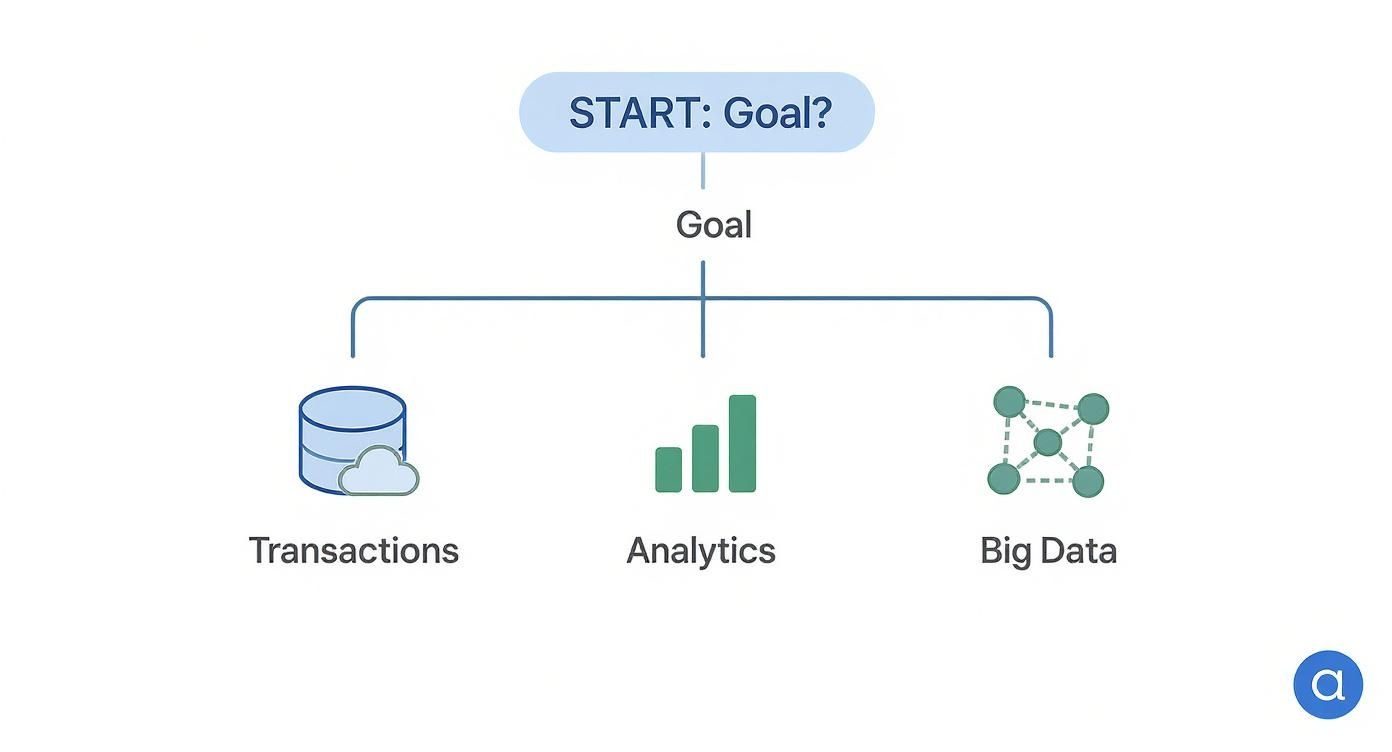Ever wondered how complex smart homes and business networks manage information without turning into a chaotic mess? The secret lies in data modeling techniques – the professional methods we use to draw a map of how data is stored, connected, and accessed.
Think of it like this: you wouldn't build a luxury villa without an architect's blueprint. That blueprint ensures every room, wire, and pipe is in the right place, making the final structure stable and functional. Data modelling is the exact same concept, but for your information systems. It's the essential planning phase that comes before any installation begins, guaranteeing the end result is logical, reliable, and built to last.
Your Blueprint for Smarter Systems Design

Let's get practical. Imagine you’re tasked with a major multi-building fibre upgrade in London, or a high-end Wi-Fi and CCTV installation for a luxury villa in Estepona. You'd never just show up and start drilling holes or running cables randomly, would you? Of course not. You’d need a detailed plan. The same goes for data. Without that solid blueprint, you end up with a system that's confusing, unreliable, and simply not fit for purpose.
Here at MTL Smart Solutions, our reputation for building high-performance systems across the UK and Spain (Costa del Sol) comes from our obsession with meticulous planning. This focus on detail is in our DNA, whether we're designing complex network infrastructure with Cat6a cabling and PoE switches or integrating a sophisticated smart home automation system. We bring this exact same level of rigour to structuring data, because we know a solid foundation isn't just nice to have—it's absolutely essential for success.
The Foundation of Reliable Systems
When you get data modelling right, you ensure all your information is organised in a way that makes sense. This isn’t an academic exercise; it drives real, tangible value for high-end residential and commercial clients alike. This structured approach is the bedrock of the reliable systems we install, from a state-of-the-art Hikvision CCTV setup in Estepona to a managed Wi-Fi network in a London office.
Just like we make sure every Cat6a cable and PoE switch is perfectly placed for optimal performance, data modelling ensures every byte of information has a logical and efficient home. To get a better handle on the basics, this A Beginner's Guide to Data Modeling is a fantastic resource for understanding the core principles.
So, what are the big wins?
- Enhanced Consistency: It forces all your data into a uniform format, which is brilliant for stopping errors and contradictions before they start.
- Improved Performance: A well-thought-out model means the system can find and process data much faster. This is crucial for real-time operations, like security alerts from a CCTV system or instant commands in a smart home.
- Greater Scalability: It builds a flexible framework that can easily grow as you add new devices, services, or data sources, saving you from a costly and painful overhaul down the line.
Just as a professionally designed network backbone supports seamless connectivity, a robust data model supports seamless information flow. Both are invisible foundations of modern technology that demand expert planning and attention to detail.
Whether we're bringing top-tier UK engineering standards to our clients on the Costa del Sol (including Sotogrande, Estepona, and Manilva) or upgrading a commercial network in London, the core principles of structure, logic, and reliability never change. This guide will walk you through the essential data modeling techniques that are the engine behind today’s most innovative systems.
Ready to build a reliable technology foundation for your property? Contact MTL Smart Solutions for a consultation on your next project.
The Conceptual Model: Your Big-Picture Blueprint

Think about any major project you've ever tackled. Maybe it was a multi-building fibre upgrade in London or a luxury villa renovation in Estepona. Before a single cable is laid or a wall is touched, everyone involved needs to be on the same page, right? You need a shared vision.
That's exactly what a conceptual data model is. It’s the high-level sketch, the initial blueprint that captures the entire scope of your information world.
This first stage isn't the time for getting bogged down in technical details like database schemas. Far from it! It’s all about communication and understanding the business or residential requirements. The whole point is to define the 'what,' not the 'how'. We're just trying to identify the core components of your operation—the essential "things" the system truly needs to manage—and then figure out how they all connect.
Getting this right from the start is absolutely crucial. It ensures that the technology we build ultimately serves your goals, not the other way around. It gets everyone, from stakeholders to the engineers on the ground, speaking the same language and prevents costly misunderstandings that can derail a project.
Defining Your Core Business Entities
Let's make this real. Imagine we were creating a conceptual model to manage a luxury villa's smart home and security system in Sotogrande. Before we even think about network hardware like Ubiquiti switches or Hikvision CCTV cameras, we need to nail down the fundamentals.
What are the core "things" in this system?
- Rooms: Each has a unique name and contains various devices.
- Users: The individuals who can control the system, each with defined access rights.
- Devices: This covers every piece of equipment, from smart lights to security sensors and AV receivers.
- Scenes: Pre-programmed settings, like "Movie Night" or "Away Mode," that control multiple devices at once.
- Alerts: Notifications generated by the security system, linked to specific sensors and times.
See how simple that is? At this high level, all we're doing is establishing that a 'Room' can contain multiple 'Devices', and an 'Alert' must be triggered by a 'Device'. This straightforward map is completely independent of technology, but it’s the strategic bedrock everything else is built on.
The conceptual model is the foundational conversation. It ensures that the sophisticated network infrastructure we design aligns perfectly with your operational reality, whether you're in the UK or on the Costa del Sol.
This process is absolutely central to how we operate at MTL Smart Solutions. By bringing that renowned UK engineering precision to our smart home installation Spain projects, we make certain the technology plan is grounded in a deep understanding of your goals. We map out the relationships between every smart device, security sensor, and user before finalising a technical plan. It’s this meticulous attention to detail that allows us to guarantee rock-solid reliability.
Whether our clients need a professional Wi-Fi system design London or a complete CCTV installation Estepona, this conceptual phase is completely non-negotiable. It’s the master plan that ensures the finished system isn't just technically brilliant, but a perfect reflection of your vision.
Ready to turn your vision into a robust, reliable technology plan? Contact MTL Smart Solutions to book a consultation with our network infrastructure experts in the UK and on the Costa del Sol.
The Logical Model: Adding Structure and Rules
Think of the conceptual model as the architect's first sketch. It's the big idea. The logical model, on the other hand, is the detailed blueprint. This is where we get serious, adding the crucial structure and rules that will actually make the system work.
We start fleshing out our core ideas with attributes—the specific details that matter. This could be a user's name, a device's IP address, or the exact date a new CCTV system was installed. It’s all about adding that next layer of critical detail.
This stage is absolutely vital because it maps out all the business logic without getting tied to any specific technology. It’s a completely platform-agnostic plan. Developers and engineers can pick it up and know exactly what to build, ensuring the whole structure is sound before anyone touches a piece of hardware or writes a single line of code. It's how we approach every project at MTL Smart Solutions, whether we're delivering a fibre backbone installation in London or a luxury AV system on the Costa del Sol.
From Blueprint to Business Logic
Let's imagine we're designing a sophisticated smart home and AV system for a new luxury villa in Estepona. The logical model is where we'd meticulously define every single element.
- Lutron Lighting Scene: Attributes would include
Scene_Name,Room_ID,Brightness_Level, andActivation_Time. - Sonos Speaker Zone: We'd specify attributes like
Zone_Name,Location,Default_Volume, andPaired_Devices. - Hikvision CCTV Camera: Here, we need details like
Camera_Model,Resolution,Recording_Schedule, andMotion_Detection_Sensitivity.
This model also locks in the relationships and rules between all these different parts. For instance, we might set a rule that every "Security Alert" must be linked to a specific camera and an exact timestamp. It's this level of clarity that allows us to build the seamless, utterly reliable systems our clients expect.
A great logical model eliminates guesswork and prevents errors before they happen. It’s the technical discipline that ensures every component of a complex system works together harmoniously, just like a perfectly configured network.
This is also the point where we roll up our sleeves and get into data normalisation. It's a technical term for a powerful idea: organising data to reduce repetition and keep everything clean and consistent. We break down large chunks of information into smaller, related tables. This is fundamental for building systems that can grow and perform brilliantly under pressure.
This structured thinking is key to building anything robust and efficient. To see how these exact principles apply to physical hardware, check out our guide on creating the best home network setup. The same dedication to planning and structure that makes a world-class data model also underpins a high-performance network.
Whether we’re designing a Wi-Fi system design London or a smart home installation Spain, this meticulous planning phase is how we deliver the same high standard of UK engineering excellence, every single time. It’s this fanatical attention to detail that truly sets our network infrastructure experts apart.
Ready to build a system on a rock-solid foundation? Contact MTL Smart Solutions for a tailored quote and expert consultation.
The Physical Model: Bringing Your Data to Life

Here's where the architectural blueprint meets the construction site. The physical data model is the final, concrete plan that turns our carefully structured logical design into an actual, working database system. It's the most granular of all the data modeling techniques, getting right down to the 'how' of it all.
Think of it this way: we’re no longer talking about abstract concepts. We're defining the specific implementation. Whether we're building on SQL Server, Oracle, or a modern NoSQL database, this model lays out the precise technical specifications. We define exact table and column names, pin down data types (like text, integer, or date), and set up the primary and foreign keys that lock in the crucial relationships between our data.
This is the final, indispensable step before a single line of code is written to build the system. It's the detailed instruction manual our engineers follow to construct a powerful, high-performance database.
From Technical Plan to Real-World Performance
The physical model is where all that meticulous planning directly impacts system speed and reliability. A well-designed physical model means data can be found and fetched quickly and efficiently. And that’s absolutely critical for the snappy, responsive performance our clients expect from their smart home and security systems.
For example, you could take the same logical design for a client management system and implement it in two completely different ways depending on the goal:
For High-Speed Transactions: Imagine a system handling real-time security alerts from a Hikvision or Ubiquiti CCTV installation Estepona. We’d optimise the physical model for lightning-fast read/write operations, using specific indexing strategies to guarantee instant access to critical data. It has to be quick.
For Large-Scale Analytics: Now, picture a system analysing network traffic across a sprawling multi-building fibre backbone in London. The physical model would be structured totally differently. Here, we'd prioritise efficient querying over massive datasets to spot performance trends over time.
The physical data model is where engineering precision becomes performance reality. Just as the right PoE switch and Cat6a cabling ensure network speed, the right physical data model ensures your information system is fast, stable, and reliable.
At MTL Smart Solutions, our expertise as network infrastructure experts UK and Costa del Sol is founded on this obsessive attention to detail. We apply the same rigorous UK engineering standards to our database work as we do to our physical installations. This focus on innovation and reliability is also at the heart of how we design high-capacity networks; have a look at our approach to powerful, professionally managed Wi-Fi solutions for business to see how we build systems for maximum speed and reliability.
This final blueprint is the culmination of all the planning that came before it, providing the exact schema needed to bring your data to life with integrity and speed.
Choosing the Right Data Modelling Technique
Now that we’ve covered the different levels of data modelling, let's talk about picking the right technique. It's a bit like choosing the right tool for a construction job. You wouldn't use the same equipment for a massive fibre optic upgrade across a London high-rise as you would for a subtle, high-end AV integration in a villa in Estepona. It’s the same with data – different challenges demand different approaches.
The decision you make here will fundamentally shape how well your systems run, from day-to-day transactional databases to high-level business intelligence platforms.
At MTL Smart Solutions, our philosophy is built on matching the right technology to the specific environment. This doesn't just apply to network hardware; it's just as crucial for data architecture. We bring that same exacting standard of UK engineering and professionalism to our Spanish clients, ensuring every system is built on a solid, perfectly suited foundation.
Relational vs. Dimensional Models
Let's start with the two heavyweights: the Relational Model and the Dimensional Model. The Relational Model is the absolute backbone of countless transactional systems. It organises data into meticulously normalised tables to guarantee consistency and reduce redundant information. Think of it as the perfect choice for systems where data integrity is king, like managing client accounts or processing commands from a smart home automation system.
On the other hand, the Dimensional Model is the go-to for data warehousing and business analytics. It simplifies the structure into "facts" (like sales figures or sensor readings) and "dimensions" (like time, location, or device type). When building a data warehouse, it's always smart to lean on established principles, like the best practices in data warehousing. This technique is built for speed and efficiency, making it brilliant for generating reports and pulling real insights from massive datasets.
The Rise of NoSQL Models for Complex Data
Today’s world throws a lot of messy, unstructured data at us—data that just won't squeeze neatly into traditional rows and columns. This is where NoSQL data models (like Document, Key-Value, and Graph) really come into their own. They are specifically engineered for the sheer scale and flexibility that modern applications demand.
Take the Graph Model, for instance. It's incredibly powerful for mapping out complex relationships. Imagine trying to visualise every single connection in a sophisticated network infrastructure project in Sotogrande—every switch, access point, and connected device. A graph model makes understanding these tangled dependencies almost intuitive, which is an absolute game-changer for troubleshooting and optimisation. This deep understanding is central to our professional managed network services.
A recent UK survey drives home the importance of these advanced digital skills. While almost 90% of UK firms have adopted at least one advanced digital technology, expertise isn't spread evenly. Adoption is highest in London (65%) and in larger firms (80%), which shows how much expert guidance is needed. You can read more about these digital technology adoption findings in the UK.
Let's pull all this together with a quick comparison.
Comparison of Common Data Modeling Techniques
Here's a straightforward look at the most widely used data modelling techniques, where they shine, and what makes them tick.
| Technique | Primary Use Case | Structure | Strengths |
|---|---|---|---|
| Relational | Transactional Systems (OLTP) | Normalised tables with rows and columns | High data integrity, reduces redundancy, ensures consistency (ACID compliance) |
| Dimensional | Data Warehousing (OLAP) | Fact and dimension tables (Star/Snowflake Schema) | Optimised for fast queries, easy to understand for business users, great for analytics |
| Document (NoSQL) | Content Management, IoT Data | JSON/BSON documents in collections | Flexible schema, handles semi-structured data beautifully, scales horizontally |
| Key-Value (NoSQL) | Caching, Session Management | Simple key-value pairs | Extremely fast reads/writes, highly scalable, simple data model |
| Graph (NoSQL) | Social Networks, Recommendation Engines | Nodes, edges, and properties | Excellent for analysing complex relationships and interconnected data |
Ultimately, choosing the right data modelling technique is the bedrock of building reliable, high-performance systems. It’s what ensures your data architecture can support your goals, whether that’s split-second transactional speed or deep, strategic insight.
For a closer look at how we build the physical layer that underpins all these powerful systems, check out our approach to high-performance connectivity solutions.
Ready to ensure your project is built on the right foundation from the ground up? Contact MTL Smart Solutions to request a site visit from our network infrastructure experts in the UK and on the Costa del Sol.
The Future of Data Modelling in the UK
Data modelling is evolving at a breakneck pace, driven by the incredible rise of AI and machine learning. Having clean, perfectly structured data isn't just a "nice to have" anymore—it's the high-octane fuel powering the algorithms that are completely reshaping how businesses operate in the UK.
We live and breathe this at MTL Smart Solutions. Whether we're architecting a seamless network for a smart home installation in Spain or setting up a complex, multi-site CCTV system in London, it all comes back to the data structure. Get the data modelling right, and suddenly, the tidal wave of information from cameras, sensors, and smart devices becomes organised, actionable intelligence.
This little infographic is a great starting point. Think of it as a decision tree to help you figure out which modelling technique fits what you're trying to achieve.

As you can see, your end goal is everything. Are you focused on rock-solid transactional data? Deep-dive analytics? Or wrangling enormous datasets? Your answer points you down the right path from the very beginning.
This isn't just a trend; it's an acceleration. A recent government report found that a whopping 68% of large UK firms have already adopted at least one AI solution. Even more telling, the use of machine learning is set to more than double. This explosive growth drives home just how critical it is to get a solid grip on data modelling. You can dive into the details in the full AI Activity in UK Businesses Report.
From crafting intelligent smart spaces to guaranteeing your network never lets you down, mastering your data is the name of the game.
Ready to lay a data and network foundation that's built for tomorrow? Contact MTL Smart Solutions to book your consultation today.
Got Questions About Data Modelling? We've Got Answers
We've explored the main data modelling techniques, but it's completely normal for questions to pop up. Let's tackle some of the most common ones we hear from our clients across the UK and Spain, breaking them down into simple, practical answers.
Which Data Modelling Technique Is the Most Common?
Historically, the Relational Model is hands down the most widespread technique. It’s the solid, reliable foundation for countless databases where consistency is non-negotiable. Think of it as the bedrock for processing transactions in your smart home system or managing client information without a single error.
That said, when the goal shifts to business analytics, Dimensional Modelling is incredibly popular for a reason. And for the really big, flexible jobs—like wrangling data from thousands of smart devices—NoSQL models are quickly becoming the new go-to standard.
How Do I Pick the Right Technique for My Project?
This is the golden question! Your choice should always come back to what you're trying to achieve. The best data modelling technique is simply the one that’s right for the job.
Here’s a quick way to think about it:
- Transactional Systems: Need iron-clad integrity for e-commerce payments or security alert logs? The Relational Model is your most dependable bet.
- Analytics and Reporting: Is your main goal to slice and dice data to spot trends? A Dimensional Model is built from the ground up for speedy, efficient queries.
- Complex or Unstructured Data: If you're dealing with messy, intricate relationships, like mapping the entire network infrastructure in a Sotogrande villa, a NoSQL Graph Model is leagues ahead of the others.
Can Data Modelling Actually Improve Business Performance?
Without a doubt. Getting your data modelling right leads to better data quality, less wasted space, and much faster system performance. It’s a game-changer.
In the UK, while many smaller firms are still dipping their toes into advanced analytics, the potential waiting to be unlocked is huge. It's estimated that tapping into technologies like data modelling could inject an extra £232 billion into the UK economy every single year. You can read more about these UK economic impact findings.
Ultimately, it all translates into more trustworthy reports and a rock-solid foundation for making smarter, faster decisions.
A powerful data and network foundation is the key to unlocking the true potential of your property. MTL Smart Solutions are the network infrastructure experts for the UK and Costa del Sol, ready to design a system that fits your exact needs. Contact us today for a professional consultation.





Comments are closed